What Environmental Factors Influence Chinchilla Coat Color?
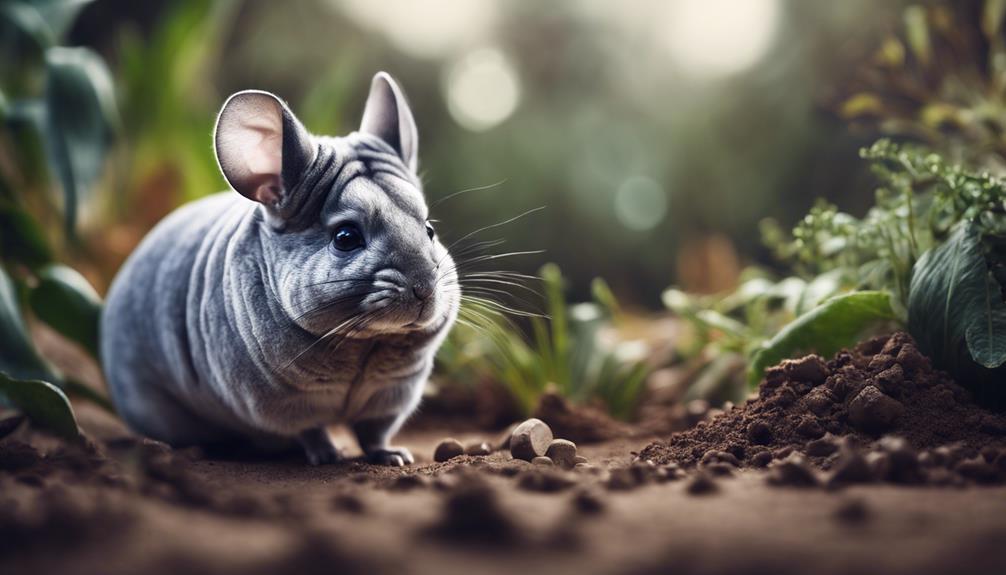
Environmental factors such as diet, sunlight exposure, and temperature can influence a chinchilla's coat color.
Understanding these factors can provide insights into the genetics and adaptations of these adorable creatures.
Diet
Dietary intake significantly impacts the coat color of chinchillas through mechanisms involving nutrient absorption and metabolism. Chinchillas have specific nutritional requirements essential for maintaining optimal coat color. The digestive health of these animals plays a crucial role in ensuring that they can effectively absorb and utilize the necessary nutrients for coat pigmentation.
Chinchillas require a diet rich in high-quality hay, a moderate amount of pellets, and limited treats to support their coat color. Hay provides essential fiber for digestive health, while pellets are formulated to meet their specific nutritional needs. Ensuring the chinchilla's digestive system is functioning properly is vital for the absorption of key nutrients that influence coat color.
Sunlight Exposure
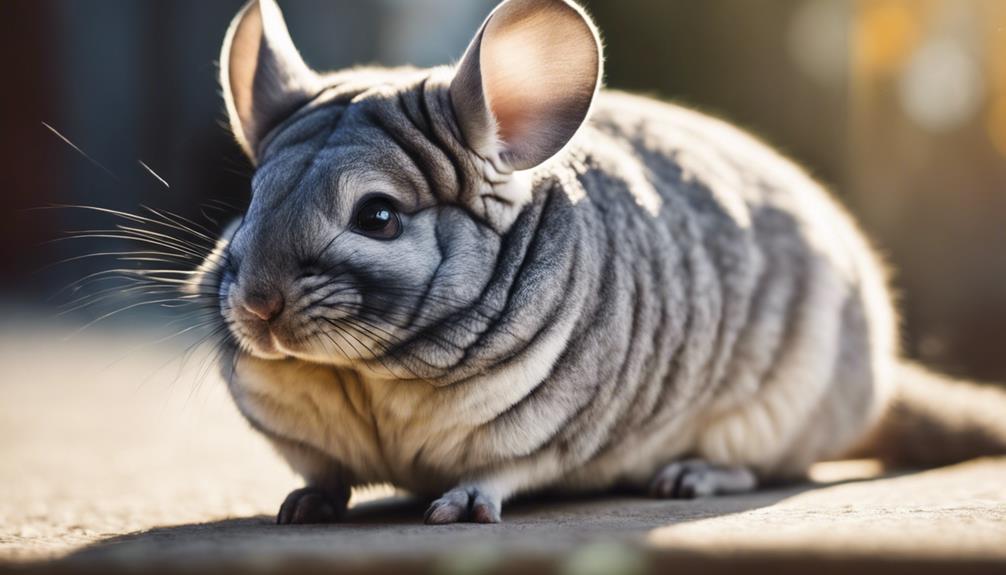
Sunlight exposure plays a crucial role in influencing the coat color of chinchillas by affecting the production of melanin in their fur. UV radiation from sunlight can lead to pigmentation changes in chinchilla fur, causing shifts in their coat color based on the light intensity they are exposed to. The varying wavelengths of sunlight can impact the synthesis of melanin, which is responsible for the coloration of the fur in chinchillas. Light intensity plays a significant role in determining the extent of color shifts in chinchilla coats, with prolonged exposure to intense sunlight potentially leading to noticeable changes in pigmentation.
| UV Radiation Effects | Pigmentation Changes |
|---|---|
| Alters melanin production | Shifts coat color |
| Impacts fur pigments | Influences fur darkness |
Understanding the effects of sunlight exposure on chinchilla coat color is essential for ensuring the well-being of these animals. By controlling their exposure to sunlight, whether natural or artificial, chinchilla owners can help maintain the desired coloration of their pets' fur.
Temperature Fluctuations
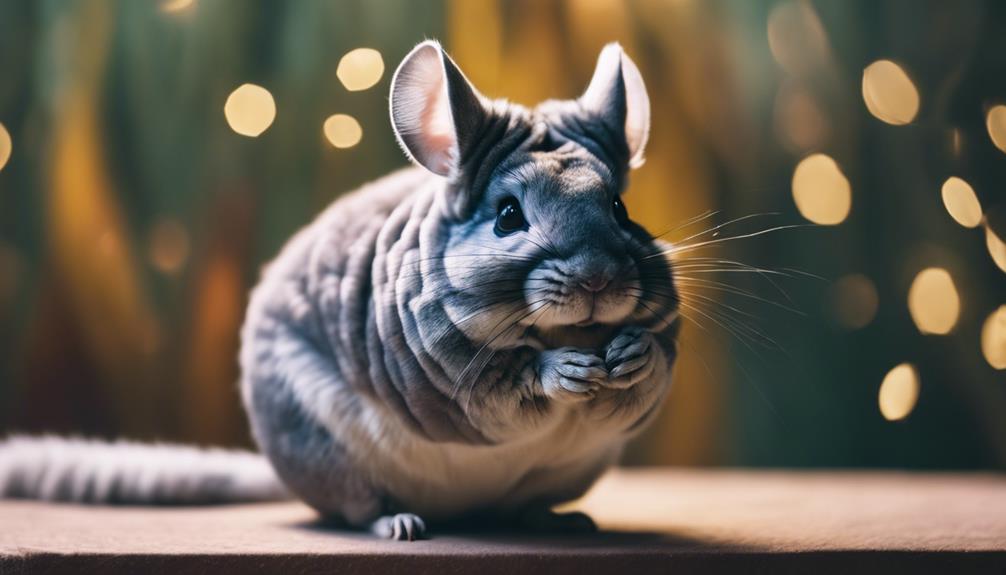
Temperature fluctuations can impact chinchilla coat color through their influence on genes responsible for melanin production. The variations in temperature can affect the expression of these genes, leading to changes in the amount and distribution of melanin in the fur.
Understanding how temperature fluctuations interact with coat color genes is crucial for comprehending the adaptive responses of chinchillas to their environment.
Coat Color Genes
Exposure to fluctuating temperatures can influence the expression of coat color genes in chinchillas. Genetic inheritance plays a crucial role in determining the coloration of a chinchilla's coat, with specific genes controlling pigment expression. Temperature changes can impact the regulation of these genes, leading to variations in coat color. Below is a table illustrating how temperature fluctuations can affect the expression of coat color genes in chinchillas:
| Temperature | Effect on Coat Color |
|---|---|
| High | Intensifies pigmentation |
| Low | Dilutes pigmentation |
| Fluctuating | Inconsistent color patterns |
| Stable | Consistent color expression |
| Extreme | Alters coat color entirely |
Melanin Production
Genetic factors influencing coat color in chinchillas also impact melanin production in response to temperature fluctuations. Hormonal regulation plays a crucial role in pigmentation control, with variations in temperature triggering hormonal responses that affect melanin synthesis.
Chinchillas have evolved mechanisms to adjust their melanin production based on environmental cues, providing evolutionary advantages such as camouflage and thermoregulation. Temperature fluctuations can influence the distribution and intensity of melanin in the chinchilla's coat, leading to color variations that help these small mammals adapt to changing environmental conditions.
Understanding how melanin production is modulated by hormonal regulation in response to temperature changes sheds light on the intricate relationship between environmental factors and chinchilla coat color.
Habitat Diversity
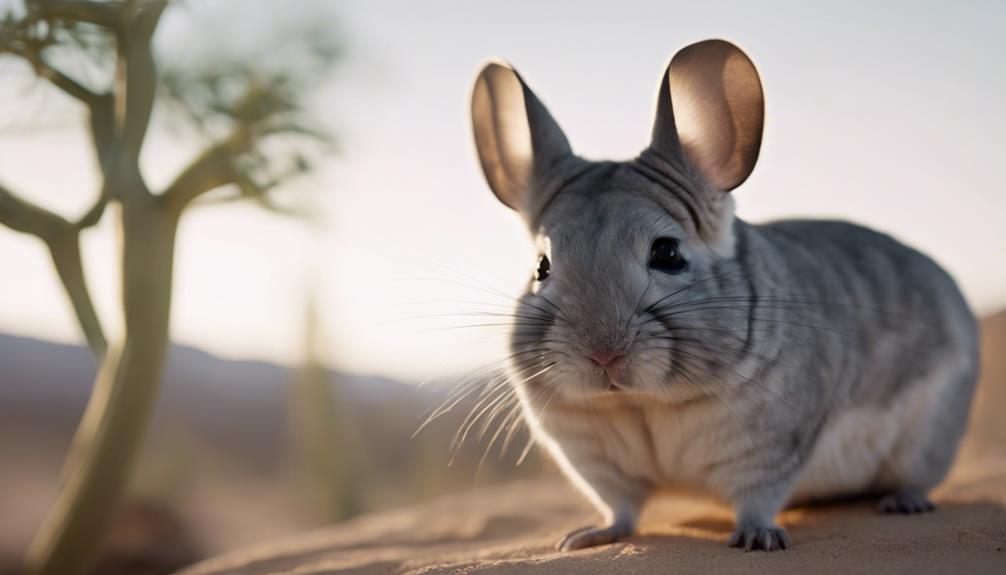
Habitat diversity plays a crucial role in shaping the coat color of chinchillas. The climate of the region influences the thickness and coloration of their fur, aiding in their camouflage and insulation.
Chinchillas have evolved to adapt to various altitudes and habitats, showcasing a range of coat colors to blend in with their surroundings.
Climate Impact on Fur
The diverse climates in which chinchillas reside directly impact the color and quality of their fur.
- Temperature Fluctuations: Extreme temperatures can stress chinchillas, affecting their fur coloration and thickness.
- Humidity Levels: High humidity can lead to fungal infections that compromise the quality of the fur.
- Precipitation Patterns: Excessive moisture from rain or snow can cause fur matting and decrease insulation.
- Seasonal Changes: Shifts in weather patterns influence chinchillas' molting cycles, affecting coat pigmentation and environmental conditions.
Altitude and Coloration
Altitude plays a significant role in determining the coloration of chinchilla fur due to the varying environmental conditions at different elevations.
Chinchillas have developed altitude adaptations to cope with changes in oxygen levels, ultraviolet radiation, and temperature gradients. These factors directly impact the color variation observed in chinchilla populations across different altitudes.
At higher altitudes, where UV radiation is more intense, chinchillas tend to have darker fur to provide better protection against sun damage. In contrast, chinchillas at lower altitudes may exhibit lighter fur shades.
This color variation is a result of evolutionary processes that have favored specific coat colors to enhance chinchillas' survival and camouflage abilities in their respective altitude environments.
Adaptation to Surroundings
Chinchilla coat coloration demonstrates a remarkable ability to adapt to the diverse environmental conditions of their habitats, showcasing evolutionary responses that optimize their camouflage and survival strategies.
- Color Camouflage: Chinchillas living in rocky terrains often have gray fur, blending seamlessly with the surroundings to evade predators.
- Environmental Selection: In areas with dense vegetation, chinchillas with darker fur shades are more prevalent, as this coloration aids in concealing them from sight.
- Habitat Diversity: Chinchillas inhabiting snowy regions tend to have white coats, providing effective camouflage against the snow-covered landscapes.
- Adaptive Evolution: Through natural selection, chinchillas have evolved coat colors that enhance their chances of survival in various habitats.
Stress Levels
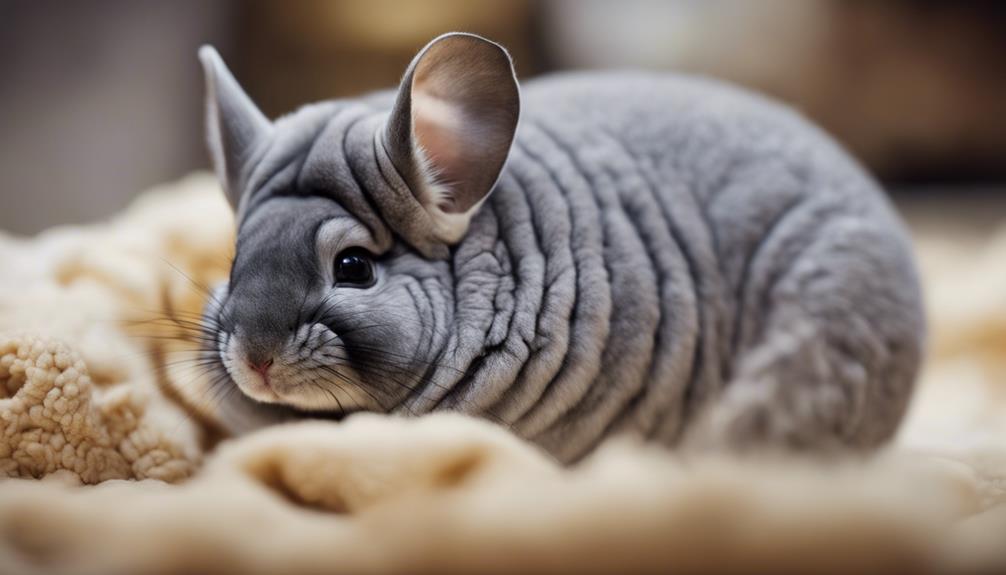
Exposure to high levels of stress can have a significant impact on chinchilla coat coloration. While coat color genetics primarily determine the baseline color of a chinchilla, hormonal influence can alter coat color under stress. The stress response triggers the release of certain hormones that can affect the production of pigments responsible for coat coloration. In nature, this mechanism may provide an evolutionary advantage by allowing chinchillas to adapt to stressful situations efficiently.
Chinchillas facing chronic stress may exhibit changes in coat color due to the hormonal fluctuations induced by the stress response. This alteration in coat coloration could serve as a visual cue to other chinchillas regarding the individual's stress levels or health status. Understanding how stress influences coat color can provide insights into the overall well-being of chinchillas and help caretakers identify and address potential stressors in their environment promptly. By monitoring coat color changes alongside other indicators of stress, such as behavior and physical health, chinchilla owners can better support the welfare of their furry companions.
Seasonal Changes
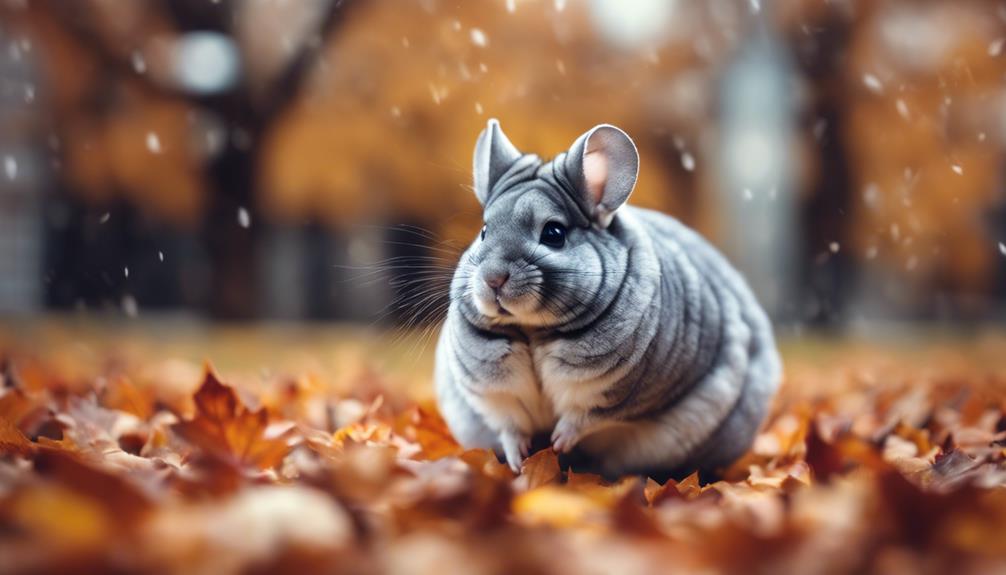
- Fur shedding patterns: Chinchillas exhibit seasonal fur shedding known as molting. During molting, old fur is replaced by new fur, which can impact the overall coat color of the chinchilla.
- Environmental triggers: Factors like temperature and daylight duration can influence the chinchilla's coat color. In response to environmental cues, chinchillas may adapt their coat pigmentation to better suit their surroundings.
- Color changes: Seasonal changes can lead to alterations in the chinchilla's coat color. For instance, chinchillas living in snowy environments might develop a lighter coat during winter to blend in with the surroundings.
- Coat pigmentation: The intensity of UV radiation can affect the production of melanin in chinchilla fur, resulting in seasonal variations in coat color. Chinchillas may adjust their coat pigmentation to provide better protection against the sun during summer months.
Genetic Interactions
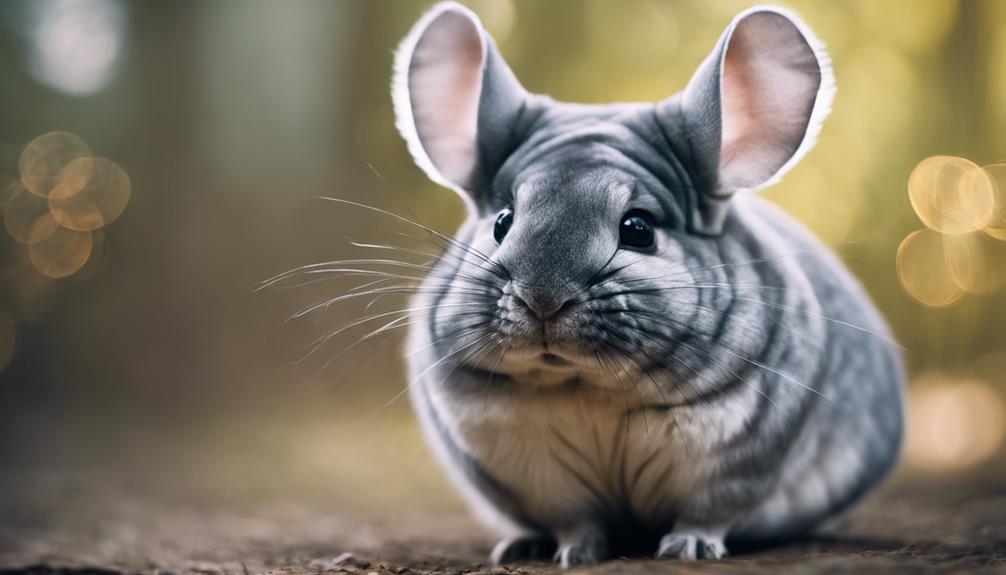
Seasonal changes in chinchilla coat color are influenced by complex genetic interactions that regulate pigmentation pathways. These genetic interactions play a crucial role in determining the phenotypic variation observed in chinchilla coat colors. Phenotypic variation refers to the different observable traits resulting from the interactions between an organism's genetic makeup and its environment. In chinchillas, genetic interactions can lead to a wide range of coat colors, from beige to black, with various shades in between.
Crossbreeding outcomes also highlight the importance of genetic interactions in determining chinchilla coat color. When chinchillas with different coat colors are bred together, the offspring's coat color can vary significantly based on the genetic combinations inherited from their parents. Understanding these genetic interactions is essential for breeders looking to produce chinchillas with specific coat colors or patterns.
Frequently Asked Questions
Can Chinchillas Change Their Coat Color Based on Their Diet Alone?
Chinchillas cannot change their coat color based solely on diet; it's primarily determined by genetics. However, dietary supplements may support coat health. Grooming habits play a vital role in maintaining coat quality. Factors beyond diet influence coat color changes.
How Does Habitat Diversity Affect the Coat Color of a Chinchilla?
In the wild, habitat diversity poses varied environmental pressures on chinchillas, influencing their coat color through climate adaptation. Evolutionary advantages in camouflage effectiveness drive the selection of coat colors that best suit their surroundings, aiding in survival.
Are Stress Levels a Major Factor in Determining Chinchilla Coat Color?
Stress levels may affect chinchilla coat color through hormonal fluctuations. Genetics, social hierarchy, and diet also play roles. Understanding how these factors interact can provide insight into the mechanisms behind coat color variation in chinchillas.
Can Seasonal Changes Impact the Coat Color of a Chinchilla?
Seasonal variations play a crucial role in chinchilla coat color changes. Breeding patterns coincide with these shifts, impacting the pigmentation process. Understanding how seasonal cues influence coat color can provide valuable insights into chinchilla breeding and health.
Do Genetic Interactions Play a Role in the Variation of Chinchilla Coat Colors?
Genetic inheritance plays a fundamental role in the variation of chinchilla coat colors. While environmental influences can affect pigmentation, the intricate interactions of genes largely determine the specific hues and patterns observed in chinchilla fur.











